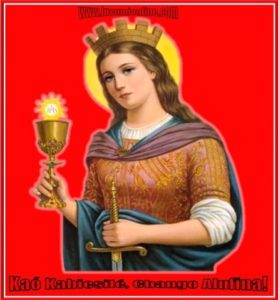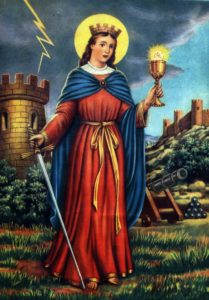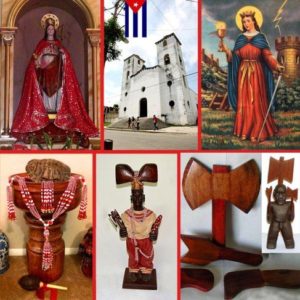 SANTA BARBARA AND HER DEVOTEES OF THE YORUBA SHANGÓ.
SANTA BARBARA AND HER DEVOTEES OF THE YORUBA SHANGÓ.
Santa Barbara was a virgin and Christian martyr of the third century, is part of the official list of the martyrology of the Catholic Church and according to the catholic calendar or saint its holiday is celebrated on December 4. It is usually depicted either with the palm of martyrdom or with peacock feathers, because this animal is a symbol of resurrection or immortality, and appears in the oldest known representation, dating from the eighth century in Santa Maria la Antigua, from Rome.
In the most known image in our country it usually appears with its attribute: a tower with three windows and in others, the tower appears next to it or in miniature on one of its hands. The meaning of this tower with three windows is the refuge of faith in the Holy Trinity. It usually carries a crown, which admits variations: in some it is that of a princess and in others it is a complete crown made up of several towers.
The image of Santa Barbara also appears sometimes associated with the sword with which she was beheaded, which has contributed to it being associated with the war, but this sword represents a symbol of unshakeable faith and with a chalice, which means her conversion to Catholicism. Sometimes he carries an olive branch in his hands, representing martyrdom. But always with his red cloak, chalice of the blood of Christ.
Changó or Shangó (in Yoruba, Ṣàngó) is a god of the Yoruba religion. Shangó in the syncretism is compared to Santa Bárbara, who has his party on December 4, according to the Catholic calendar. His day of the week is Saturday, although Friday is also popular. Its number is 6 and its multiples, although some award it 4, perhaps because of its religious syncretism with Santa Bárbara. Its colors are red and white and its necklace is also made of beads of that color. Greetings Kaó Kabiesilé, Shango Alufina!
Shangó is one of the most popular Orishas of the Yoruba pantheon. He is considered Orisha of thunder, lightning, justice, virility, dance and fire. Shango is a warrior Osha, the king of the Yoruba religion and one of the most popular Orishas of his pantheon. Shango is an Osha and is in the group of Oshas de cabecera. Orisha of justice, dance, virile strength, thunder, lightning and fire, owner of the Batá, Wemileres, Ilú Batá or Bembés drums, of dance and music; it represents the need and joy of living, the intensity of life, masculine beauty, passion, intelligence and riches. He is the owner of the religious system of Osha-Ifá.
To Shangó is offered the amalá made from corn flour, milk and okra, green plantains, oti, Indian plantain, red wine, toasted corn, barley, birdseed, etc. They are slaughtered rams, roosters, quail, jicotea (river turtle), guinea fowl, pigeons, etc. Its ewe are the punch bledo, atiponlá, platanillo de Cuba, Ceiba, paradise, cedar, poplar, baria, zarzaparilla, bey hawksbill, red vine, almacigo, camagua, cimarrona, sugarcane, onion, mahogany, flamboyan, white guano , guano prieto, laurel, corn, bitter stick, mamey colorado, palo boma, jicotea grass, pinion, pinion botija, okra, rompesaragüey, rue, tomato, travesera, yaya, palm, peony, mint, clover, canistel, filigree, yaba and others.
 SANTA BARBARA BENDITA Y SUS DEVOTOS DEL YORUBA SHANGÓ.
SANTA BARBARA BENDITA Y SUS DEVOTOS DEL YORUBA SHANGÓ.
Santa Bárbara fue una virgen y mártir cristiana del siglo III, forma parte de la lista oficial del martirologio de la Iglesia Católica y según el calendario o santoral católico su fiesta se celebra el 4 de diciembre. Se le suele representar bien con la palma del martirio o bien con plumas de pavo real, pues este animal es símbolo de la resurrección o la inmortalidad, y aparece ya en la más antigua representación conocida, que data del siglo VIII en Santa María la Antigua, de Roma.
En la imagen más conocida en nuestro país suele aparecer con su atributo: una torre con tres ventanas y en otras, la torre aparece a su lado o en miniatura sobre una de sus manos. El significado de esta torre con tres ventanas es el refugio de la fe en la Santísima Trinidad. Suele llevar corona, que admite variaciones: en algunas es la de una princesa y en otras es una corona completa formada de varias torres.
La imagen de santa Bárbara también aparece a veces asociada con la espada con la cual fue decapitada, lo que ha contribuido a que sea asociada con la guerra, pero dicha espada representa un símbolo de fe inquebrantable y con un cáliz, que significa su conversión al catolicismo.
En ocasiones lleva una rama de olivo entre sus manos, representando el martirio. Pero siempre con su manto rojo, cáliz de la sangre de Cristo.
Changó o Shangó (en yoruba, Ṣàngó ) es un dios de la religión yoruba. Shangó en el sincretismo se compara con Santa Bárbara, la cual tiene su fiesta el 4 de Diciembre, de acuerdo al calendario santoral católico. Su día de la semana es el sábado, aunque el viernes también es popular. Su número es el 6 y sus múltiplos, aunque algunos le adjudican el 4, quizás por su sincretismo religioso con Santa Bárbara. Sus colores son el rojo y blanco y su collar también es de cuentas de ese color. Se saluda ¡Kaó Kabiesilé, Shango Alufina!
Shangó es uno de los más populares Orishas del panteón Yoruba. Es considerado Orisha de los truenos, los rayos, la justicia, la virilidad, la danza y el fuego. Shango es un Osha guerrero, el rey de la religión Yoruba y uno de los Orishas más populares de su panteón. Shango es un Osha y está en el grupo de los Oshas de cabecera. Orisha de la justicia, la danza, la fuerza viril, los truenos, los rayos y el fuego, dueño de los tambores Batá, Wemileres, Ilú Batá o Bembés, del baile y la música; representa la necesidad y la alegría de vivir, la intensidad de la vida, la belleza masculina, la pasión, la inteligencia y las riquezas. Es el dueño del sistema religioso de Osha-Ifá.
A Shangó se le ofrenda amalá hecha a base de harina de maíz, leche y quimbombó, plátanos verdes, otí, plátano indio, vino tinto, maíz tostado, cebada, alpiste, etc. Se le inmolan carneros, gallos, codornices, jicotea (tortuga de río), gallina de guinea, palomas, etc. Sus ewe son el bledo punzó, atiponlá, platanillo de Cuba, Ceiba, paraíso, cedro, álamo, baría, zarzaparilla, bejuco carey, bejuco colorado, almácigo, camagua, combustera cimarrona, caña de azúcar, cebolla, caoba, flamboyán, guano blanco, guano prieto, laurel, maíz, palo amargo, mamey colorado, palo boma, hierba jicotea, piñón, piñón botija, quimbombó, rompesaragüey, ruda, tomate, travesera, yaya, palma, peonía, hierbabuena, trébol, canistel, filigrana, yaba y otros.
Agencies/Memoria Cubanas/ Derubín Jácome/ Internet Photos/ Arnoldo Varona/ thecubanhistory.com
THE CUBAN HISTORY, HOLLYWOOD.







